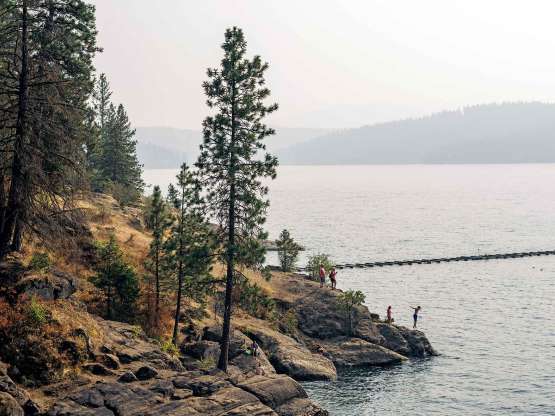Photo: Tubbs Hill on Lake Coeur d’Alene. – Kyle Johnson for Bloomberg Businessweek
The Bunker Hill Mine deposited 75 million tons of toxic sludge in Lake Coeur d’Alene, and the lead and zinc are still flowing.
For a century, the mines of the Coeur d’Alene Mountains in North Idaho produced much of the heavy metals that made the U.S. a global superpower. Starting in the 1880s, through the rise of industrialization, the introduction of the automobile, and two world wars, a few narrow canyons in the Coeur d’Alenes yielded more than 11 million tons of zinc, lead, and silver, as much as a fifth of U.S. production.
Mining has left a mark on the culture of the Silver Valley and an indelible stain on the landscape, which remains heavily contaminated. To extract a pound of metal, mining companies had to process nearly 14 pounds of ore, and they dumped the crushed waste rock into mountain streams and along river banks. Over the course of a century, the tailings and mine drainage flowed down the 40-mile-long watershed, depositing some 75 million tons of highly toxic sludge into Lake Coeur d’Alene. House cats convulsed from drinking the water. Migratory tundra swans suffered slow deaths as their digestive tracts seized up from lead poisoning, causing both suffocation and starvation as undigested food backed up into their long necks. Children in the Silver Valley in the 1970s registered some of the highest levels of lead in their bloodstreams recorded anywhere.
By the time the area’s biggest mine, run by the Bunker Hill Mining Co., in Kellogg, closed in the early 1980s, the mines had spread a ribbon of poison from the Idaho-Montana border to Lake Coeur d’Alene and down the Spokane River all the way into Eastern Washington. In 1983, the U.S. Environmental Protection Agency declared the Bunker Hill Mine and smelter complex the nation’s second-largest Superfund site. The agency has been […]
Full article: The EPA can’t wait to reopen the mine that poisoned North Idaho
More about Idaho, mining, and public waterways:
Idaho on pace to set aquifer recharge record during 2017-18 season
Farmers drawing groundwater from Ogallala Aquifer faster than nature replaces it
EPA drops rule requiring mining companies’ funding to clean their pollution
Choosing water over gold: El Salvador bans metallic mining
“Wild, Wonderful” West Virginia’s Decapitated Mountains and Deformed Fish


